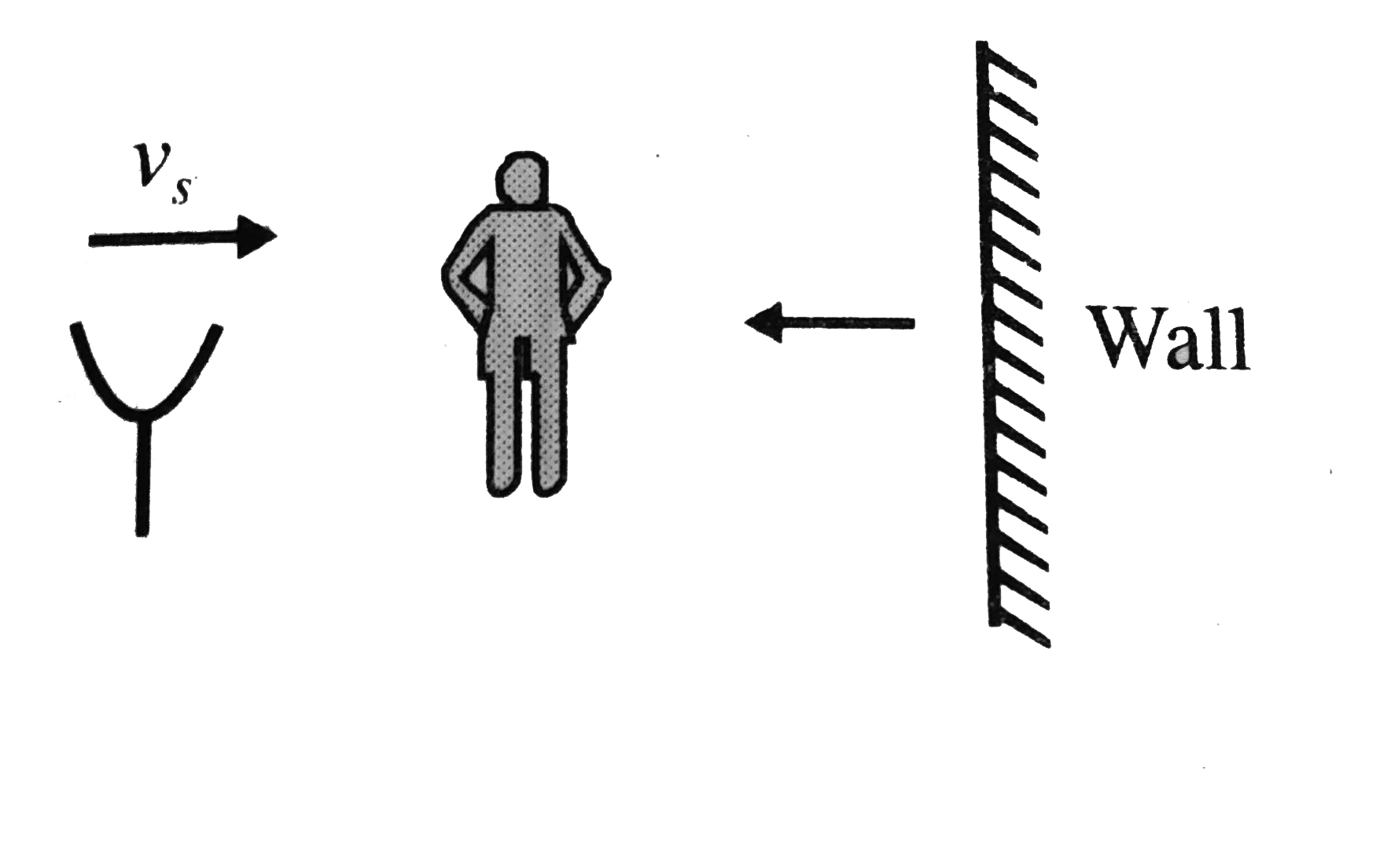A tunning fork of frequency 512Hz approaches a wall with a velocity of 4ms−1. How many beats are produced between the direct and the reflected sound if the velocity of sound is 332ms−1?
To solve the problem of how many beats are produced between the direct and the reflected sound from a tuning fork approaching a wall, we can follow these steps:
Step 1: Identify the Given Values
- Frequency of the tuning fork (f) = 512 Hz
- Velocity of the tuning fork (v_s) = 4 m/s (approaching the wall)
- Velocity of sound in air (v) = 332 m/s
Step 2: Calculate the Apparent Frequency of the Direct Sound
The apparent frequency (f') of the sound emitted by the tuning fork when it is moving towards a stationary observer (the wall) can be calculated using the Doppler effect formula:
f′=f(vv−vs)
Substituting the values:
f′=512(332332−4)
f′=512(332328)
f′=512×1.0122
f′≈518.4Hz
Step 3: Calculate the Apparent Frequency of the Reflected Sound
When the sound reflects off the wall and travels back to the observer (the tuning fork), the wall acts as a stationary source. The apparent frequency of the reflected sound (f'') can be calculated as:
f′′=f′(vv)
Since the wall is stationary, the formula simplifies to:
f′′=f′
Thus, the frequency of the reflected sound is also approximately 518.4 Hz.
Step 4: Calculate the Beat Frequency
The beat frequency is given by the difference between the frequencies of the direct sound and the reflected sound:
Beat Frequency=|f′−f′′|
Since both frequencies are equal:
Beat Frequency=|518.4−518.4|=0Hz
Conclusion
No beats are produced between the direct and the reflected sound since both frequencies are equal.
---
- Frequency of the tuning fork (f) = 512 Hz
- Velocity of the tuning fork (v_s) = 4 m/s (approaching the wall)
- Velocity of sound in air (v) = 332 m/s
The apparent frequency (f') of the sound emitted by the tuning fork when it is moving towards a stationary observer (the wall) can be calculated using the Doppler effect formula:
f′=512(332328)
f′=512×1.0122
f′≈518.4Hz
When the sound reflects off the wall and travels back to the observer (the tuning fork), the wall acts as a stationary source. The apparent frequency of the reflected sound (f'') can be calculated as:
The beat frequency is given by the difference between the frequencies of the direct sound and the reflected sound:
No beats are produced between the direct and the reflected sound since both frequencies are equal.
Topper's Solved these Questions
- WAVESBook:ICSEChapter:WAVESExercise:Sound Waves
Explore 50 Videos
- WAVESBook:ICSEChapter:WAVESExercise:Musical Sound
Explore 2 Videos
- WAVESBook:ICSEChapter:WAVESExercise:Solved Examples
Explore 17 Videos
- VECTORS SCALARS ELEMENTARY CALCULUS Book:ICSEChapter:VECTORS SCALARS ELEMENTARY CALCULUS Exercise:UNSOLVED PROBLEMS
Explore 79 Videos
Similar Questions

A tuning fork of frequency 380 Hz is moving towards a wall with a velocity of 4ms Then the number of beats heard by a stationary listener between direct and reflected sound will be (velocity of sound in air is 340ms)
View SolutionA source of sound of frequency 256 Hz moves rapidly towards a wall with a velocity of 5ms−1. How many beats per second will be heard if sound travels at a speed of 330 m/s?
View Solution
Knowledge Check
A policeman blows a whistle with a frequency of 500 Hz.A car approaches him with a velocity of 15ms−1.Calculate the change in frequency as heard by the driver of the car as he passes the policeman. Speed of sound in air is 300ms−1. a) 25 Hz b) 50 Hz c) 100 Hz d) 150 Hz
A25 HzB50 HzC100 HzD150 Hz
A source of sound of frequency 256Hz is moving rapidly towards wall with a velocity of 5m/sec. How many beats per second will be heard if sound travels at a speed of 330m/sec.
View SolutionA sound source emitting sound of frequency 450 Hz is approaching a stationary observer with velocity 30ms−1 and another identical source is going away from the observer with the same velocity. If the velocity of sound is 330ms−1, then the difference of frequencies heard by observer is
View SolutionA vehicle sounding a whistle of frequency 256Hz is moving on a straight road,towards a hill with velocity of 10ms−1. The number of beats per second observed by a person travelling in the vehicle is (velocity of sound = 300ms−1
View SolutionA whistle giving 700 Hz moves away from a stationary observer towards a wall with a velocity of 2 m/s. How many beats per second are heard by the observer ? [Velocity of sound = 348m/s]
View SolutionA tuning fork of frequency 100 Hz emits a wave of wavelength 4m. What is the temperature of the atmosphere, if the velocity of sound at 27∘C is 330m/s?
View SolutionA tuning fork of frequency 256 Hz produces 4 beats per second when sounded with a stringed instrument. What is the frequency produced by the instrument?
View SolutionA man standing 25 m away from a wall produces a sound and receives the reflected sound.
Calculate the time after which he receives the reflected sound if the speed of sound in air is 350ms−1.
View Solution
